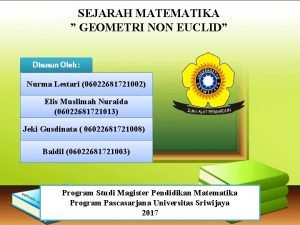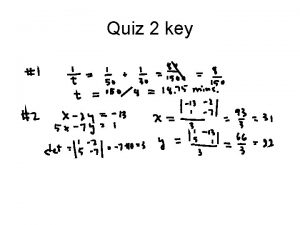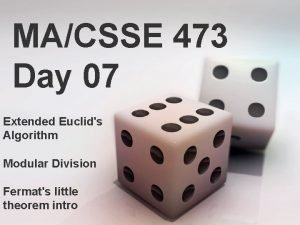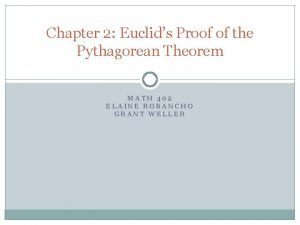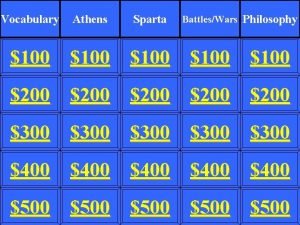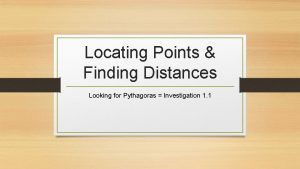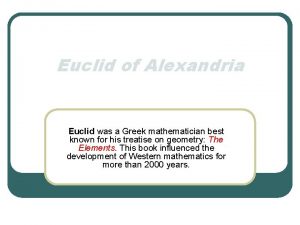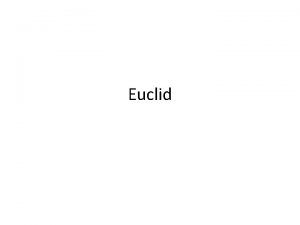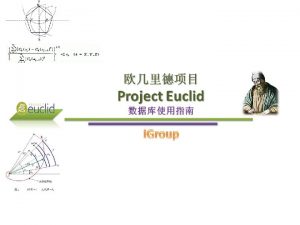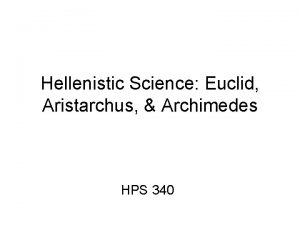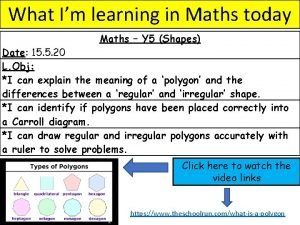Writing maths from Euclid to today ONE EUCLID










![FIVE: EULER • Euler writes: “we set [such-and-such] = [his new symbol]”. Another way FIVE: EULER • Euler writes: “we set [such-and-such] = [his new symbol]”. Another way](https://slidetodoc.com/presentation_image_h2/9e13cee8aa3e47ed8220d0495f597d3c/image-11.jpg)
- Slides: 11

Writing maths, from Euclid to today ONE: EUCLID The first maths book of all time, and “the” maths book for most of the last 2300 years, was Euclid’s Elements. Here the bit from it on Pythagoras’s Theorem. What do you notice about Euclid’s way of writing maths which is different from the way your textbook or you would write maths today?

TWO: DURELL Euclid’s book was used not only as a historical reference, but as a school textbook, for centuries. Some time in the 19 th century writers started to produce books which gave the same ideas as Euclid, but written differently. This is the same proof of Pythagoras’s theorem as written out by Clement Durell, whose maths textbooks dominated schools in England from early in the 20 th century until the 1960 s. What is different about Durell’s way of writing?

THREE: A MORE MODERN PROOF OF PYTHAGORAS Since Euclid, well over 300 other proofs of Pythagoras’s theorem have been written. Here is one. Why bother to find another proof when we already have one? What is different about this one?

FOUR: ANOTHER EUCLID PROOF IN THE ORIGINAL, AND IN A MODERN WRITING Here is Euclid’s proof that there are infinitely many primes, and a modern writing-out of the same proof. What is different about the modern writing-out?

FIVE: EULER This is a page from the writing of the 18 th century mathematician Leonhard Euler, who invented many of the symbols we use today to make mathematical writing more concise. Notice that Euler uses so many symbols that he has to call in a different typeface How does he tell his readers what these symbols mean?

SIX: CAYLEY This is a bit from one of the articles, in the 1850 s, when the British mathematician Arthur Cayley explained to the world that he had discovered “matrices”, and how to do calculations with them. What seems odd about the way this article is printed? Why?

SEVEN: RIEMANN This is the beginning of one of the half-dozen most epoch-making lectures in the history of mathematics, by Bernhard Riemann in Göttingen in June 1854. In the whole lecture there are just twelve mathematical symbols, five equals signs, three square-root signs, and four Σ signs. How come?

SEVEN: LITTLEWOOD AND HARDY The early 20 th century British mathematician J E Littlewood made it a rule for himself to keep all his working on any problem – any problem, and he worked on some very difficult ones – on one side of one sheet of paper. If the paper got too crowded or messy, he wrote his working out again, more concisely. His friend G H Hardy, with whom he co-wrote many articles, was also very concerned to keep his working neat and concise. When he wanted to understand another mathematician’s work, his usual method was to write out the working himself, as concisely as he could. Both benefited from unusually clear handwriting. Why would it be a good idea to keep all your work on one side of a sheet of paper?

EIGHT: COHEN, VILLANI & MOUHOT, AND LANGLANDS The excerpt from Paul Cohen is from his 1964 book, Set Theory and the Continuum Hypothesis, in which he announced a startling new result and a whole new method of proof. From Robert Langlands we have an excerpt from his letter to Andre Weil of 1967 which started a research program which 50 years later still dominates whole areas of pure maths, "the Langlands conjecture". The excerpt from Cédric Villani and Clément Mouhot is from their article on the subject of “Landau damping” in mathematical physics which won Villani the Fields Medal in 2010. Have words and diagrams dropped out of modern advanced maths? When Villani and Mouhot finish a bit of working, how do they flag it up?

ONE: EUCLID • There a lot of words • And no algebra (algebra hadn’t been invented) • The words are written out as continuous text, like any other book, not as distinct lines separated by spaces. (This would have been partly because paper was very expensive then). • The style is conversational, not as in “Hi, Euclid, how’s it going? ” type conversation, but philosophical conversation in which the author is writing to convince. “I say that the square on BC equals the sum of the squares on BA and AC…”, and so on. • The diagram is very important • One thing that remains constant throughout all good mathematical writing goes right back to Euclid: At the start, he tells the reader exactly what he's trying to do. When he reaches the conclusion, he tells the reader – “Here it is. This is the conclusion”. He flags it up. TWO: DURELL • Durell makes the proof much shorter, and as concise as possible, by using abbreviations and special symbols • The proof is written in distinct lines. Each line is spaced out from the line before and the line after (not running on continuously like writing in ordinary books). Each line follows logically from the line before it. THREE: MODERN PYTHAGORAS PROOF • Very little writing: the diagram does most of the work. • But no algebra. The proof is all diagram plus words. • Euclid’s proof was written to convince. Successfully. No-one in 2300 years has ever disputed that the proof is logically sound. But this proof is better because it is shorter, more vivid, and conveys better the idea that theorem has to be true. FOUR: ANOTHER EUCLID PROOF IN THE ORIGINAL, AND IN A MODERN WRITING • The modern writing-out uses more abbreviations and special symbols – algebra, which hadn’t been discovered in Euclid’s time – to make it shorter. But algebra doesn’t replace all words. It is just a way of abbreviating words. • Euclid gives a diagram. The modern proof doesn’t. I think that is because mathematicians of Euclid’s time regarded geometry as basic, and numbers as measures of lines, while today we tend to regard numbers as more basic.
![FIVE EULER Euler writes we set suchandsuch his new symbol Another way FIVE: EULER • Euler writes: “we set [such-and-such] = [his new symbol]”. Another way](https://slidetodoc.com/presentation_image_h2/9e13cee8aa3e47ed8220d0495f597d3c/image-11.jpg)
FIVE: EULER • Euler writes: “we set [such-and-such] = [his new symbol]”. Another way of saying that is: “Call [such-and-such] [new symbol]” The most common way today is: “Let [new symbol]=[such-and-such]” One way or another, the writer tells the reader: this is a new symbol, and this is what it means. SIX: CAYLEY • The notation for matrices, with brackets round the first row connected to vertical lines around the other rows, looks odd to us today. I suspect it was dictated by what printers could manage in those days. The lesson is that mathematical writing today depends on hundreds of piecemeal inventions of new abbreviations and symbols, all designed to make it more concise. SEVEN: RIEMANN • A bit of mathematical working can have lots of symbols and few words when it is mainly a calculation based on ideas which both writer and reader know well. The more imaginative and thoughtful the maths, the more need it has of words. SEVEN: HARDY AND LITTLEWOOD • Keeping all your working on one side of a page, if you can, makes it concise. It makes it easier for the reader, and for you, to understand the whole argument, and especially not to lose thread when you turn the page. EIGHT: COHEN AND VILLANI & MOUHOT • Words and diagrams are still very important. And flagging up clearly to the reader when you have reached your conclusion, and what it is.
